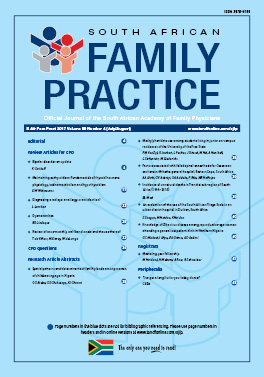Factors associated with failed spinal anaesthesia for Caesarean sections in Mthatha general hospital, Eastern Cape, South Africa
Keywords:
blocked height, bloody CSF, Caesarean section, spinal anaesthesia failure, South Africa
Abstract
Background: The use of spinal anaesthesia has increased in the last three decades, given that it is the recommended anaesthetic of choice for better foetal and maternal outcomes in Caesarean section. Failed spinal anaesthesia (FSA) exposes patients to unfavourable experience of pain and the potential complications of general anaesthesia that are being avoided in the first instance. This study determines the incidence and the predictors of failed spinal anaesthesia in pregnant women presenting for Caesarean section at Mthatha General Hospital, Eastern Cape. Methods: This descriptive cross-sectional study included 197 pregnant women scheduled for Caesarean section under spinal anaesthesia at Mthatha General Hospital from May 1 to August 30, 2013. A standard proforma was utilised for data collection on items of demographic, surgical and anaesthetic records of each parturient. The main outcome measure was the incidence of failed spinal anaesthesia (defined as partial or incomplete spinal block requiring conversion to general anaesthesia). Results: The incidence of failed spinal anaesthesia was 11.7%, which was slightly higher in emergency Caesarean sections. In univariate analysis, previous anaesthesia, obesity, dry tap of cerebrospinal fluid (CSF), bloody CSF and duration of work experience less than one year were significantly associated with FSA in the cohort. Conclusion: The study found a high incidence of failed spinal anaesthesia during Caesarean section in this setting. Upskilling of doctors in spinal anaesthesia is urgently needed in the study setting. (Full text of the research articles are available online at www.medpharm.tandfonline.com/ojfp) S Afr Fam Pract 2017; DOI: 10.1080/20786190.2017.1292696
Section
Research Articles
By submitting manuscripts to SAFP, authors of original articles are assigning copyright to the South African Academy of Family Physicians. Copyright of review articles are assigned to the Publisher, Medpharm Publications (Pty) Ltd, unless otherwise specified. Authors may use their own work after publication without written permission, provided they acknowledge the original source. Individuals and academic institutions may freely copy and distribute articles published in SAFP for educational and research purposes without obtaining permission.

